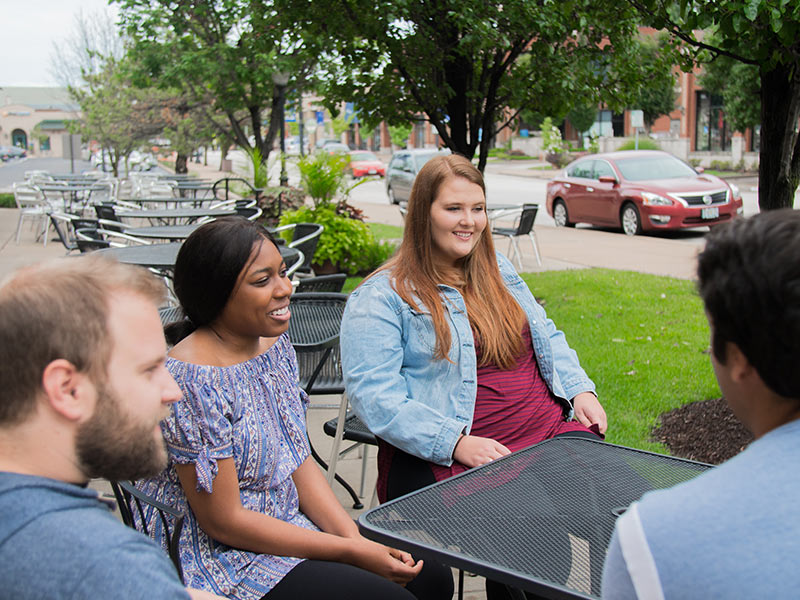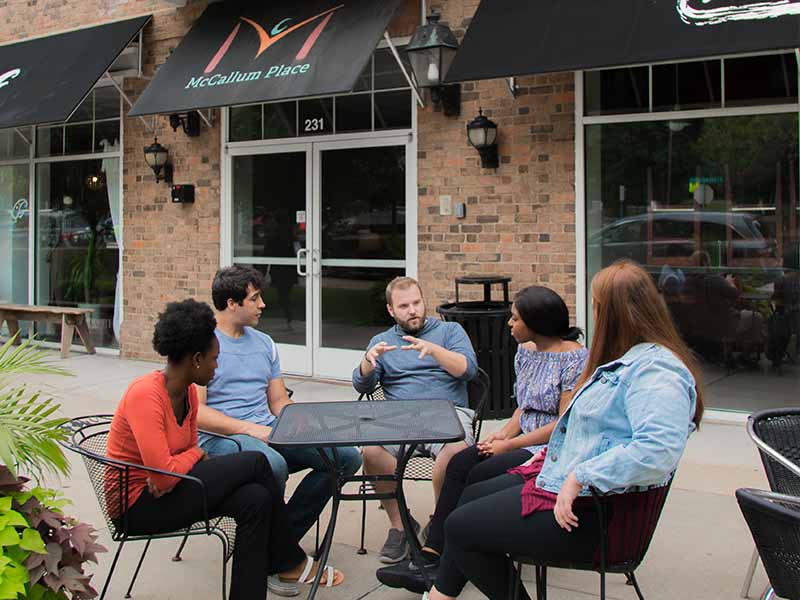Darby McBride, MA, LPC, NCC, CCTP
Individual and Group Therapist
My best mornings before coming to work include some type of meditation. This is a time when I can center myself before the start of a busy day. Do I make time for it every day? No. Sometimes I don’t get up early enough to include it in my morning routine. Sometimes there is just too much to do. But when I’m able to add it in, I feel much more at peace.
Whether or not I’ve meditated beforehand, I come in to work at McCallum Place on Monday mornings and lead home group. This is a group where patients get to check in about their day. They can talk about challenges they are facing, emotions they are experiencing, hopes and dreams for recovery, and anything else that surfaces. After home group, I start meeting with my individual patients. Throughout the day I am engaged with patients: listening to their stories, providing emotional support, and working to help them look at their illness and the recovery process in new ways. This is what I love about being a therapist.
However, I have to admit that one of the hard things about being a therapist is sitting across from these patients who are so bright, talented, and caring and hearing them putting themselves down, expecting perfection from themselves, and struggling to identify and acknowledge all of their positive qualities that seem as plain as day to me. This brings me back to my original topic: meditation.
Specifically, I want to talk about lovingkindness meditation. You may be thinking, “Lovingkindness? What’s that? It sounds too new age-y for me.” Let me explain. Lovingkindness (also known as “metta”) meditation is about creating an intention in our mind for the happiness of ourselves and all beings (Salzberg, 1995). By practicing this type of meditation we are planting seeds of love and happiness for ourselves and others.
The Practice
Before we can sit down to meditate, we need to come up with specific phrases for ourselves and others to repeat in our meditation. Our goal is to identify meaningful phrases that we wish for ourselves and for others. Each phrase will start with “May I…”, “May you…”, or “May all beings…” Some examples include “May I be safe”, “May I be happy”, “May I be healthy”, and “May I feel at peace.” Use these phrases or come up with your own.
When we sit down to practice lovingkindness, we first want to offer the phrases to ourselves. So, as you sit or lie down comfortably, eyes open or closed, repeat silently to yourself either the above phrases or the unique phrases you have identified. And as you repeat them, put some intent behind them. Consider each repetition of the phrases a gift you are giving to yourself. Repeat them at a gentle pace, without rushing or adding extra pressure.
“May I be safe. May I be happy. May I be healthy. May I feel at peace.”
(If any strong feelings arise, practice breathing into and accepting them for what they are, and then return to the phrases.)
Once we have spent a few minutes on ourselves, we can then direct our phrases of lovingkindness to someone we feel close to or inspired by. We will want to choose at least one person. If we choose more than one person, we will want to take time silently repeating the phrases for each person individually. If you cannot think of a person, perhaps you can direct the phrases to a pet!
First, picture this individual’s face, say their name to yourself, and connect with what it feels like to be in their presence (Salzberg, 2011). Then, with clear intention, offer the phrases of lovingkindness to this individual.
“May you be safe. May you be happy. May you be healthy. May you feel at peace.”
Next, we are going to offer lovingkindness to someone we know who is struggling or hurting right now. As before, we want to picture their face, say their name, and connect to their presence. As we do this, we begin repeating the phrases again.
“May you be safe. May you be happy. May you be healthy. May you feel at peace.”
(If at any point, you become distracted, return to the phrases and continue.)
Next, we want to choose someone that we don’t know well but that we may encounter occasionally. Maybe it’s the mail carrier, a cashier at the grocery store, or a neighbor. Our intent is not to get to know this person better, but rather, to offer them phrases of lovingkindness. Remember, this person wants to be happy, just as we do.
The same process applies here. As we imagine this person’s face and connect to their presence, we offer our phrases.
“May you be safe. May you be happy. May you be healthy. May you feel at peace.”
(You may find if you do this enough that you begin to feel much more connected to this person, even though you don’t know them very well! Connection is a vital need we all share. Celebrate it!)
Now, for arguably the most difficult part of this meditation, we are going to identify a difficult person in our lives. We may want to choose someone who is easier to focus on when we are just starting out. For example, we may first think of a person who irritates us or gets under our skin rather than someone who has truly hurt us. We’re going to picture this person, say their name, and connect with their presence. Repeat the phrases of lovingkindness with intention.
“May you be safe. May you be happy. May you be healthy. May you feel at peace.”
(This may be hard. If you find that it’s too hard, go back to sending yourself lovingkindness for this part of the meditation.)
Finally, we want to offer lovingkindness to all beings. This includes anything that is living: people, animals, plants, insects…everything! Open up your heart and allow the phrases to flow out to the world.
“May all beings be safe. May all beings be happy. May all beings be healthy. May all beings feel at peace.”
(At first, it may feel overwhelming trying to include all beings. Take it easy on yourself and do the best you can. It will start to feel more natural with time.)
Why Should I Practice?
If we spend a few minutes on each part of the meditation, we will reap the benefits of lovingkindness. Lovingkindness breeds compassion, joy, and equanimity (Salzberg, 1995). In practicing this specific type of meditation, we are increasing self-respect and respect for others and kindness. If we practice regularly, lovingkindness can change our relationship with ourselves in a very positive way. We may find that our relationships with others benefit from this practice as well. The Buddha taught that lovingkindness brings additional advantages to our lives, such as sleeping easily, waking easily, gaining the love of others, and having a peaceful, serene mind (Salzberg, 1995).
If you practice this meditation regularly, you may find that you can more easily connect with others throughout the day. You may find yourself repeating the phrases even when you are not meditating, allowing for more spontaneous self-compassion and generosity.
For those with eating disorders, it can be extremely beneficial to take time out of each day to breathe and practice offering lovingkindness. This practice cultivates patience and acceptance, while also wishing well for ourselves and others. It is like a blessing or a gift we can give to ourselves. I find that many of my patients struggle to take time for themselves and don’t often take care of themselves in the same way that they tend to take care of others. Practicing lovingkindness can be a positive and uplifting way to start your day. It also provides a reprieve from eating disorder thoughts, behaviors, and motivations and may provide the opportunity to see the bigger picture of life, outside of the eating disorder. This is all in addition to feeling more connected with others and our authentic selves.
It may seem like meditation takes a lot of time and dedication for us to see the full benefits. However, with lovingkindness, I have received benefits after just ten minutes of practice in a day. For me, it’s a hopeful beginning or peaceful end to the day. When I use the phrases throughout the day, I find that I feel more grounded and less stressed or anxious. Take some time to experiment and to recognize the benefits lovingkindness may give to you. All you need is ten minutes!
References:
Salzberg, S. (1995). Loving-Kindness: The Revolutionary Art of Happiness. Boston, MA: Shambhala Publications, Inc.
Salzberg, S. (2011). Real Happiness: The Power of Meditation. New York, NY: Workman Publishing Company, Inc.
McCallum Place is a nationally recognized, comprehensive eating disorder treatment center for adolescents and adults. The facility was founded in St. Louis and has opened an additional center in the Greater Kansas City area. Each clinic offers on-site medical and psychiatric management combined with intensive, individualized psychotherapy. McCallum Place’s eating disorder treatment programs provide a continuum of care, specialized to provide the right level of support to optimize recovery for each patient.









